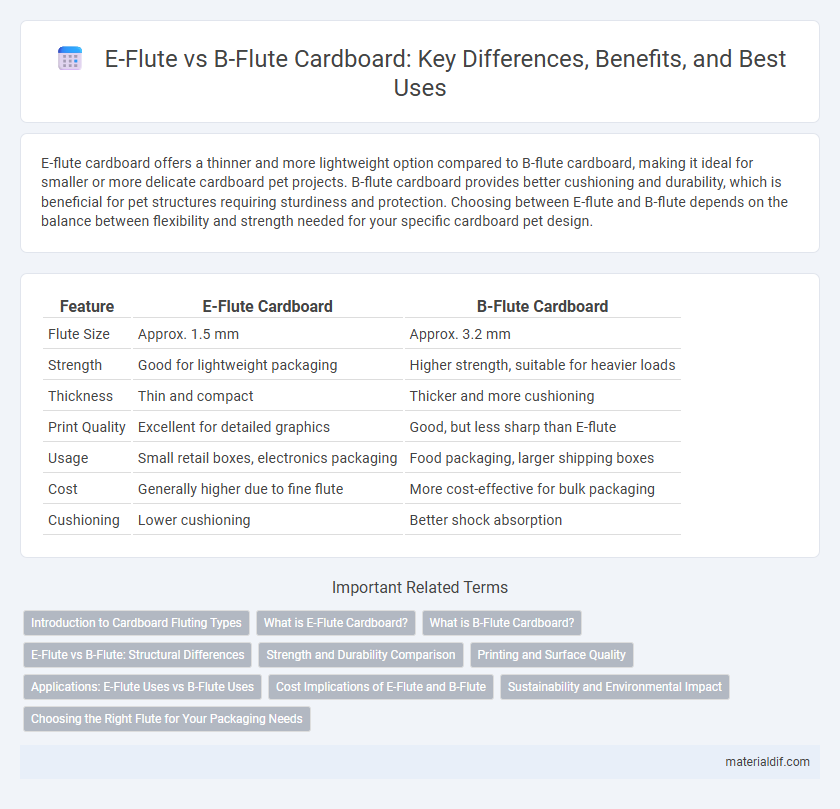E-flute cardboard offers a thinner and more lightweight option compared to B-flute cardboard, making it ideal for smaller or more delicate cardboard pet projects. B-flute cardboard provides better cushioning and durability, which is beneficial for pet structures requiring sturdiness and protection. Choosing between E-flute and B-flute depends on the balance between flexibility and strength needed for your specific cardboard pet design.
Table of Comparison
| Feature | E-Flute Cardboard | B-Flute Cardboard |
|---|---|---|
| Flute Size | Approx. 1.5 mm | Approx. 3.2 mm |
| Strength | Good for lightweight packaging | Higher strength, suitable for heavier loads |
| Thickness | Thin and compact | Thicker and more cushioning |
| Print Quality | Excellent for detailed graphics | Good, but less sharp than E-flute |
| Usage | Small retail boxes, electronics packaging | Food packaging, larger shipping boxes |
| Cost | Generally higher due to fine flute | More cost-effective for bulk packaging |
| Cushioning | Lower cushioning | Better shock absorption |
Introduction to Cardboard Fluting Types
E-flute cardboard offers a thinner profile with approximately 1.5mm thickness, providing enhanced crush resistance and a smoother surface ideal for high-quality printing. In comparison, B-flute cardboard measures around 3mm thick, delivering greater cushioning and stacking strength suitable for heavier or more fragile items. Choosing between E-flute and B-flute depends on specific packaging requirements like durability, printing quality, and space efficiency.
What is E-Flute Cardboard?
E-flute cardboard features a flute size of approximately 1.5mm, offering superior crush resistance and excellent printing surface compared to B-flute, which has a thicker 3.2mm flute. This finer flute design makes E-flute ideal for packaging smaller, delicate items requiring enhanced protection and high-quality graphics. Its lightweight nature combined with strength and print clarity supports efficient shipping and attractive retail displays.
What is B-Flute Cardboard?
B-flute cardboard features a thickness of approximately 1/8 inch with about 47 flutes per foot, providing excellent cushioning and resistance against impact for packaging fragile items. It offers superior puncture resistance and stacking strength compared to E-flute cardboard, which is thinner and typically measures around 1/16 inch with 90 flutes per foot. B-flute is ideal for shipping boxes and protective packaging where durability and strength are crucial.
E-Flute vs B-Flute: Structural Differences
E-flute cardboard features a thickness of approximately 1.5 mm with smaller, more closely spaced flutes around 90 flutes per linear foot, providing a smoother surface ideal for high-quality printing and lightweight packaging. B-flute cardboard is thicker at about 3.2 mm with fewer flutes around 47 per linear foot, offering greater cushioning and impact resistance suited for heavier products. The structural difference between E-flute's fine texture and B-flute's robust thickness influences durability, print clarity, and protection level in packaging applications.
Strength and Durability Comparison
E-flute cardboard features a flute height of approximately 1.5 mm, offering superior compression strength and excellent crush resistance, making it ideal for packaging fragile items. B-flute cardboard, with a thicker flute height around 3.2 mm, provides enhanced cushioning and impact absorption, resulting in greater durability during rough handling and extended shipping periods. The finer flutes of E-flute deliver smoother surfaces suitable for high-quality printing, while B-flute's robust structure excels in heavy-duty applications requiring enhanced protection.
Printing and Surface Quality
E-flute cardboard offers a smoother surface with finer flute size, making it ideal for high-resolution printing and detailed graphics. B-flute cardboard has a thicker flute size, providing greater cushioning but a rougher surface that may slightly reduce print sharpness. For packaging requiring vibrant colors and intricate designs, E-flute is preferred, while B-flute suits durability-focused applications with less emphasis on printing clarity.
Applications: E-Flute Uses vs B-Flute Uses
E-flute cardboard, with its thinner profile and higher flute density, is ideal for retail packaging, point-of-purchase displays, and small consumer goods where print clarity and product protection are essential. B-flute cardboard offers greater thickness and cushioning, making it suitable for shipping heavier items, bulk packaging, and industrial products requiring enhanced durability and impact resistance. The choice between E-flute and B-flute depends on balancing protection needs with printing requirements in packaging design.
Cost Implications of E-Flute and B-Flute
E-flute cardboard generally costs more than B-flute due to its thinner profile and higher precision manufacturing process, which offers increased printability and a smoother surface ideal for retail packaging. B-flute cardboard provides greater cushioning and strength at a lower cost, making it suitable for heavier or bulkier items while reducing overall packaging expenses. Choosing between E-flute and B-flute cardboard depends on balancing cost with protective and aesthetic requirements, directly impacting packaging budgets and supply chain efficiency.
Sustainability and Environmental Impact
E-flute cardboard features a thinner, more compact flute structure, resulting in less material usage and reduced carbon footprint compared to B-flute cardboard, which has thicker flutes but offers greater cushioning. E-flute's lightweight design enhances recyclability and lowers transportation emissions, making it more sustainable for packaging applications. B-flute cardboard, while providing superior protection, typically uses more raw materials and has a higher environmental impact due to increased weight and bulk.
Choosing the Right Flute for Your Packaging Needs
E-flute cardboard offers a thinner profile with excellent crush resistance, making it ideal for retail packaging and lightweight products requiring high print quality. B-flute cardboard provides superior cushioning and puncture resistance due to its thicker flutes, suited for shipping fragile items and heavier goods. Choosing the right flute depends on the balance between protection, printability, and product weight to optimize packaging performance.
E-flute Cardboard vs B-flute Cardboard Infographic

 materialdif.com
materialdif.com